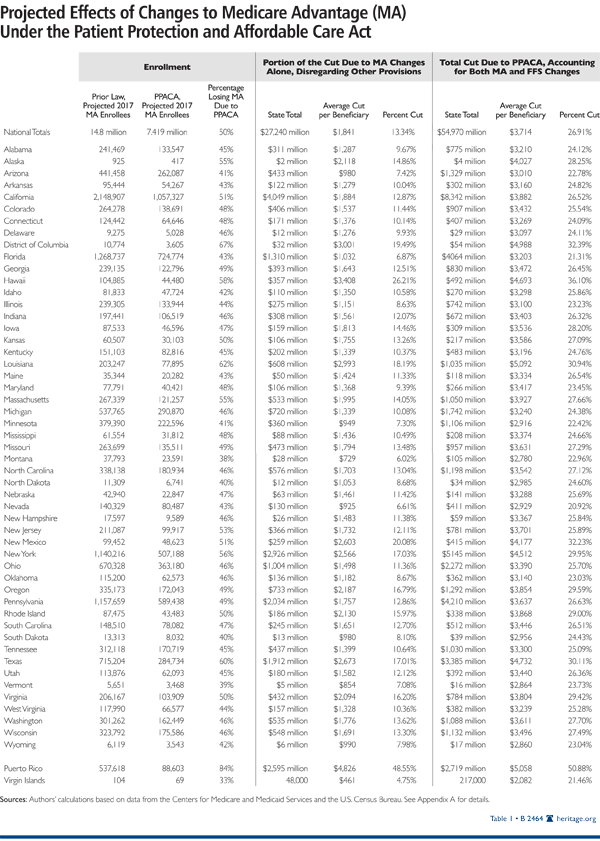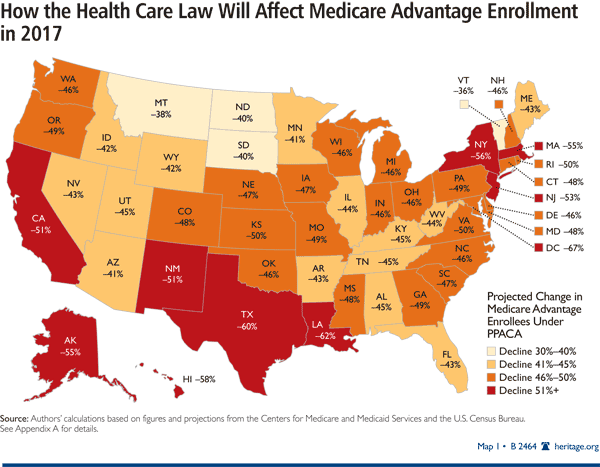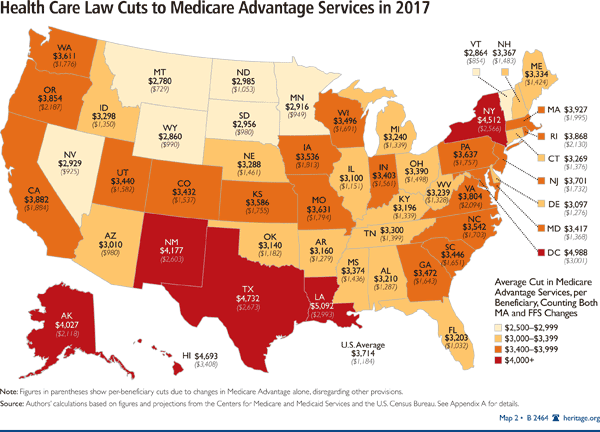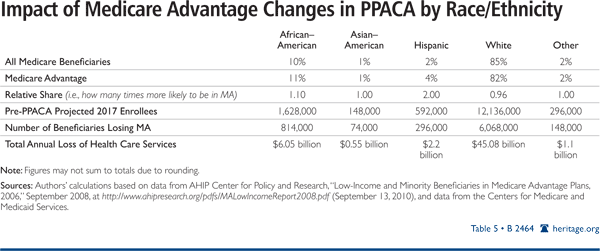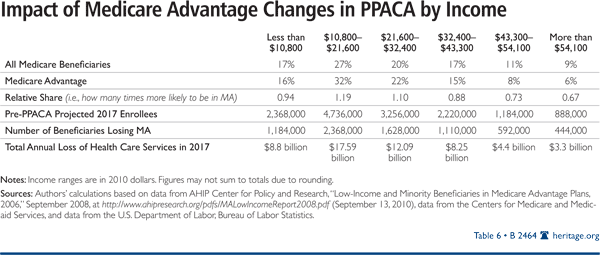Abstract: The Patient Protection and Affordable Care Act substantially alters Medicare Advantage and, as a consequence, reduces the access of senior citizens and the disabled to quality health care by restricting and worsening the health care plan options available to them. Lower-income beneficiaries, Hispanics, and African–Americans will bear a disproportionate share of the act’s Medicare Advantage payment reductions. Those reductions will also indirectly impose higher Medicaid costs on state and federal governments and lead to increased spending on prescription drugs by shifting costs to Medicare Part D.
The Patient Protection and Affordable Care Act (PPACA)[1] will cause millions of senior citizens and disabled Americans to lose billions of dollars in health care services every year by substantially reducing payments to Medicare Advantage (MA) plans.[2] The act will also dramatically reduce the ability of Medicare beneficiaries to make health care choices for themselves.
Low-income beneficiaries and minorities, especially Hispanics, will bear the brunt of the MA cuts. About three-fourths of the cuts will hit those with incomes of less than $32,400 per year in today’s dollars. The loss of benefits will also vary widely by geography, with beneficiaries in the hardest-hit counties facing cuts almost five times as large as cuts for residents in the least-hit counties. In every county, the average beneficiary will lose at least 15 percent of his or her benefits. The secondary effects of these changes will also significantly increase spending on Medicaid and Medicare Part D.
The PPACA cut Medicare Advantage deeply to offset a portion of the new non-Medicare entitlement spending contained in the legislation. Phased in between 2012 and 2017, the MA cuts will substantially restrict the ability of Medicare beneficiaries to choose the health plans that best meet their needs and will result in substantial reductions in coverage for many millions of seniors and disabled Americans. According to the Office of the Actuary at the Centers for Medicare and Medicaid Services (CMS), by 2017, when the changes are fully phased in, 14.8 million senior citizens and disabled Americans who would have had Medicare Advantage benefits under the previous law will be denied coverage for many services and incur higher out-of-pocket costs. About half will lose Medicare Advantage coverage entirely.[3] Others will stay in Medicare Advantage, but at reduced benefit levels and possibly in different plans that do not meet their needs as well.
In this paper, we provide a brief background on the Medicare Advantage program and a description of the changes made by the new legislation. Most important, we provide quantitative estimates of the impacts of these changes on Medicare patients.
Background
In 1982, Medicare had been in operation for less than two decades, but it was already clear that the program’s fee-for-service (FFS) design had serious shortcomings. Program administrators were holding down fees for each service provided to Medicare patients to control costs, but it was not working because the volume of services provided to patients was increasing so rapidly that the costs of extra services more than offset the price cuts. Separate fee schedules for each type of provider (for example, hospitals, outpatient centers, physicians, and labs) encouraged fragmentation of care, with stand-alone operations billing Medicare separately for different components of the same treatments.
Moreover, despite Medicare’s high level of spending, most seniors and disabled beneficiaries viewed the coverage as so inadequate that they purchased supplemental coverage at their own expense if they did not have access to a wraparound plan from a former employer. In fact, they continue to do so; in 2006 (the latest figures available), Medicare covered only 59 percent of FFS beneficiaries’ health care expenses, and 91.3 percent of Medicare beneficiaries had some sort of supplemental coverage.[4]
Congress sought to address these shortcomings by amending the law to give Medicare beneficiaries access to private-sector coverage options. The “risk contracting program” allowed health maintenance organizations (HMOs) to provide coverage for a fixed monthly “capitated” payment (5 percent below estimated FFS spending in a county) in exchange for accepting the full insurance risk for their patients. The program evolved gradually over the years. Non-HMO plans were permitted to participate, and the payments to private-plan alternatives were adjusted.
In 1997, the program was renamed Medicare+Choice, and the payment structure was revised substantially. In 2003, Congress renamed the program Medicare Advantage and further revised the payment structure.
The MA Payment System Before PPACA
Ideally, Medicare payments to private plans would compete on a level playing field with the traditional FFS option. One way to achieve this would be to require both private plans and FFS to be made available to Medicare beneficiaries with transparent pricing.
In the late 1990s, the leaders of the National Bipartisan Commission on the Future of Medicare recommended full competition in which sponsors of local private plans and a reformed FFS option would submit “bids” to provide Medicare-covered services in a defined region. The average bid (weighted for enrollment) could then be used as the standard payment for any plan selected by a Medicare enrollee. If an enrollee opted for a plan that charged more than the standard payment, the enrollee would pay the difference. Enrollees who opted for a less expensive plan would pocket the savings.[5]
Congress never adopted this recommendation. Opponents of competition objected to putting FFS in direct competition with private plans and to loosening the highly regulated, administratively determined payment systems for FFS that a move toward genuine competition would require. Instead, Congress has maintained the approach in which all Medicare beneficiaries pay the same national premium regardless of the actual costs in their local areas.[6]
Thus, the system has evolved into a complex, opaque administered-pricing system that uses measured FFS costs in a county as a starting point for determining private-plan payment rates. It then applies different rules for different circumstances in each county.
This approach to making payments to private plans has several serious flaws.
First, using measured FFS costs as a basis for MA payment locks in massive and, in the view of many, irrational[7] regional variations in FFS spending. In 2009, the expected monthly cost of an FFS enrollee in Dade County, Florida, was $1,213—more than twice the expected FFS spending level of $589 per month in Portland, Oregon. Many experts believe that spending in south Florida is inflated by extraordinary amounts of waste and fraud in the FFS program.[8]
Second, using average FFS spending to determine MA payments is problematic because FFS payments vary for many reasons unrelated to the factors faced by MA programs. For example, FFS payments are uniform across the country, except for certain geographic adjustment factors that are imperfectly estimated and too imprecise to reflect local market conditions. In many regions, this gives an inappropriate “advantage” to FFS because FFS pays below-cost rates for services by regulatory fiat.
In addition, per-patient FFS spending depends on both the price per service and the quantity of services provided (utilization). MA plans are expected to achieve savings by managing utilization to reduce unnecessary and duplicative services. However, in many low-density areas, utilization is very low because accessing care can be difficult. For reasons that are poorly understood, geographic variation in FFS averages reflects not only differences in Medicare’s administratively determined price adjustments, but also differences in utilization across regions.[9]
Finally, using FFS as a reference point for MA payments may be counterproductive and may actually penalize successful cost control by MA plans. Michael Chernew of Harvard University and his colleagues found that higher participation in MA managed-care plans is associated with lower per-beneficiary FFS spending at the county level.[10] The authors speculate that this may be due to a spillover effect from physicians who practice in a more efficient managed-care environment caring for their FFS patients in the same manner. If so, this correlation produces a perverse incentive when MA payments are tied to FFS costs: Successful cost cutting by MA plans leads to lower FFS spending, which in turn leads to lower MA payments. In time, lower MA payments would lead to reduced MA benefits and enrollment, which could cause FFS spending to rise, reducing or eliminating the cost benefits of more efficient care.
In 1997 and 2003, Congress amended the law, moving away from strict adherence to measured FFS costs as a basis for private-plan payment toward a system of modified bidding by the private plans measured against county-by-county benchmarks. The benchmarks originate in measured FFS costs but undergo several substantial modifications that are not uniform across the country. For instance, payment floors were added so that beneficiaries in counties with especially low measured FFS costs (for example, rural areas with low utilization) can benefit from the presence of private plans with different delivery options. In addition, because of how the benchmarks have been indexed, their rates of increase are sometimes faster than rates of increase in local FFS spending.
Private plans participating in Medicare Advantage submit bids for a monthly capitated payment for a standard beneficiary. The plans are paid what they bid, adjusted by the health status of the enrollees. If a beneficiary chooses a plan that bid under the benchmark price, the savings are divided between the government (25 percent) and beneficiaries (75 percent). Beneficiaries receive their savings in the form of additional health benefits, lower cost sharing, or a rebate on the standard Part B premium. If a beneficiary chooses a plan priced higher than the benchmark, the beneficiary pays the difference. As a result, most MA plans provide an enhanced benefit package, often at a lower cost to the beneficiary than Medicare FFS plus a supplemental plan.
The MA Cuts in the PPACA
The Patient Protection and Affordable Care Act calls for substantial changes in the Medicare Advantage payment system, primarily in the way the MA benchmarks are calculated. Under the new formula, MA benchmarks will again be tied directly to the average per-beneficiary spending under the FFS program, as measured by the program’s actuarial staff. All counties and similar jurisdictions[11] in the U.S. will be ranked in order of their average FFS spending. The MA benchmarks for each county will be an “applicable percentage” of that county’s average FFS spending, calculated as follows:
- For counties ranked in the highest quartile (the top 25 percent) by FFS spending, the MA benchmark will be 95 percent of the measured FFS spending for that county.
- For counties in the second quartile, the benchmark will be equal to the county’s measured FFS spending.
- For counties in the third quartile, the benchmark will be 107.5 percent of the county’s measured FFS spending.
- For counties in the lowest quartile, the benchmark will be 115 percent of the county’s measured FFS spending.
All counties will be treated with equal weight in these rankings, regardless of population, number of Medicare beneficiaries, or relative availability of MA.[12] The PPACA specifies that MA benchmarks for 2011 will be the same as those determined under prior law for 2010 and that the new benchmark formulas will be phased in over the next two to six years. Counties with bigger changes will adjust to the new rate over a longer period. The new formulas will be fully phased in by 2017.
The Impact of MA Cuts on Beneficiaries
According to the CMS Office of the Actuary, the new formula generally calls for a reduction in benchmarks.[13] In fact, the calculations presented in this paper show that the new formulas will reduce every county’s benchmark in 2017 relative to its projected benchmark for 2017 under prior law.[14]
Because MA health plans are required to rebate “excess” payments to their beneficiaries in some combination of extra health care benefits, lower co-payments, or lower Part B premiums, the reduction in benchmarks will necessarily make MA plans less generous for patients. This translates into a loss in benefits (or money) for patients who stay in MA plans. This loss may prompt some patients to switch to FFS, which will entail a loss of value relative to their options under prior law.
In addition, some MA insurers will have difficulty generating sufficient margins, or just breaking even, in some regions of the country, thus leading them to shut down some or all of their plan offerings. This will force current or potential enrollees to enroll in less-preferred options, such as FFS or a less-preferred MA plan if one is still available. Due to these factors, the CMS actuary projects that enrollment in MA plans in 2017, when the MA cuts are fully phased in, will be about half (7.4 million) of what it would have been under prior law (14.8 million).[15] In other words, half of those who would have chosen MA under prior law either will be unable to enroll in MA plans at all or will no longer find it attractive to do so.
Regardless of which outcome a particular patient experiences, every patient who would have enrolled in an MA plan under prior law will experience a loss in the value of his or her Medicare coverage.
Transferring beneficiaries from MA to FFS will also have the secondary effect of increasing Medicaid and Medicare Part D spending by almost $2.5 billion in 2017. This does not include higher out-of-pocket spending by patients for what will generally be lower levels of health care services.
In other words, instead of reducing waste, the MA cuts will simply cut health care services available to patients and transfer spending from Medicare Advantage to other federal programs and other payers (including patients), thus increasing federal and state spending on Medicaid and patient spending on Part D, supplemental care plans, and out-of-pocket costs.
Analyzing the MA Reductions
There are two approaches to analyzing how the PPACA will affect MA payment rates. The first approach isolates the impact of the change in the MA payment. This method implicitly assumes that county FFS averages will remain as they would have been under prior law.[16] This estimate accounts for both the reduction in MA benchmarks for those who retain MA and the difference between FFS payments and MA benchmarks for those who voluntarily or involuntarily drop MA.
However, other provisions of the PPACA will significantly change FFS payments, indirectly lowering MA payments by substantial amounts. The second approach accounts for this and determines the combined effect of the MA payment formula change and FFS cuts on MA rates. It will more closely reflect what Medicare enrollees will actually experience in 2017 under the new law. This paper presents results using both methods.[17]
Results
By 2017, Medicare beneficiaries who would have enrolled in Medicare Advantage under prior law will lose an average of $1,841 due to the MA changes alone and $3,714 when the effects of the entire bill, including the FFS cuts, are considered. Because the effects vary by geographic area, we estimate the dollar value of the lost benefits and the number of beneficiaries who lose MA for each state, county,[18] and congressional district.[19] Table 1 shows the estimates for each state in 2017, including projected drops in enrollment and reductions in benefits.
The CMS Office of the Actuary estimates that the PPACA will force 7.4 million people (50 percent of enrollees) out of the health plans they would have chosen under prior law and into the FFS program. We find substantial geographic diversity in this effect, ranging from 38 percent in Montana to 62 percent in Louisiana, with a 67 percent loss in the District of Columbia and a striking 84 percent loss in Puerto Rico. (See Map 1.) These percentages do not include those who would lose access to their preferred MA plan but would enroll in another MA plan instead of FFS.
Overall, 14.8 million would-be enrollees will sustain a loss in the value of their health care coverage. Of those, almost 7.4 million will either lose their access to MA plans entirely or drop out of MA “voluntarily” because the reduced benefits make MA less attractive. By 2017, the average enrollee will lose $3,714 in health care services per year, totaling $54.97 billion for all such beneficiaries. The benefit losses will vary widely by state from a low of $2,780 in Montana to a high of $5,092 in Louisiana. (See Map 2.)
At the county level,[20] the impact varies widely. Furthermore, the pattern of disparities differs significantly depending on the unit of measurement: average per-beneficiary service cuts in dollars, average per-beneficiary service cuts as a percentage, or the percentage of beneficiaries who will be transitioned entirely out of the MA program. Table 2 shows the counties with the 30 largest and 30 smallest impacts in terms of reduced enrollment, Table 3 shows the counties with the 30 largest and 30 smallest impacts in dollars of loss, and Table 4 shows the counties with the 30 largest and 30 smallest impacts in the percentage loss.[21]



Impact by Race/Ethnicity and Income. Minority Medicare beneficiaries are disproportionately represented among MA enrollees today. Compared to the average Medicare beneficiary, Hispanics are twice as likely and African–Americans are 10 percent more likely to enroll in MA. As Table 5 shows, the MA cuts in the PPACA are projected to cause Hispanics to lose $2.3 billion in benefits and African– Americans to lose more than $6.4 billion in benefits. Almost 300,000 Hispanics and more than 800,000 African–Americans will lose access to MA. These figures are almost certainly underestimates because the proportion of the Medicare population in these groups will likely increase over time.
Impact by Income. Disproportionately high numbers of lower-income Medicare beneficiaries select MA. This is understandable because MA plans are usually associated with lower co-pays and deductibles than FFS, and lower-income beneficiaries are less likely to obtain other sources of supplemental coverage, such as employer-sponsored retiree supplemental plans or Medigap, which is generally more expensive to the patient than MA.
Compared to the average beneficiary, those with incomes (in today’s dollars) between $10,800 and $21,600 are 19 percent more likely to select MA, and those with incomes between $21,600 and $32,400 are 10 percent more likely to enroll in MA. However, the very lowest-income group (annual incomes less than $10,800) is actually slightly (6 percent) less likely to enroll in MA.[22] This is probably because more of them are eligible for Medicaid coverage of Medicare co-pays and deductibles as well as services not covered by Medicare.
As Table 6 shows, more than 10.3 million Medicare beneficiaries with incomes under $32,400 in today’s dollars are projected to lose a total of $38.5 billion per year in health care services delivered (measured in federal spending, with the usual caveats). This represents 70 percent of the entire cut. More than 5 million will lose all access to MA. Furthermore, because the dollar value of a particular beneficiary’s loss is related only to the county of residence and not to income status, those with lower incomes will sustain losses that are much higher percentages of their income. In effect, the MA cuts are a regressive tax that disproportionately punishes low-income seniors and low-income disabled beneficiaries.
Increased Medicaid Spending. Many low-income Medicare beneficiaries are also eligible for Medicaid. Depending on their precise income situation, these “dual-eligibles” may receive assistance through the Medicaid program to offset their Part B premiums and possibly their Part A and Part B co-pays. The dual-eligibles are also eligible to select an MA plan. When they do, they often do not see the need to pursue Medicaid coverage because MA plans typically charge much lower co-pays than FFS. However, when dual-eligible beneficiaries lose their MA plans, many will sign up with Medicaid and thus increase both federal and state Medicaid costs.
The size of this increase could be staggering. The average dual-eligible beneficiary enrolled in MA in 2005 cost the Medicaid program only $30 per year but would cost the Medicaid program an estimated $1,128 annually if he or she transitioned to FFS.[23] Table 7 shows this figure projected forward to 2017. An estimated 472,000 dual-eligibles will lose their MA plans, increasing Medicaid costs by $924 million. These assumptions are generous (to the PPACA) in the sense that Medicaid spending is growing faster than total health spending and the PPACA substantially expands Medicaid eligibility in addition to cutting MA. This calculation accounts only for the changes in MA.
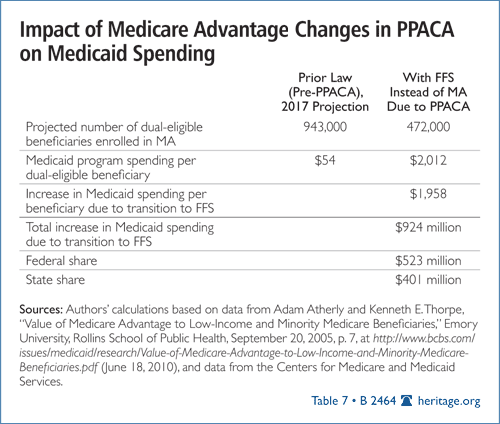
Increased Part D Spending. Medicare Part D covers prescription drugs. As with MA, Part D benefits are offered through private-sector companies that submit bids to provide prescription drug coverage, even for Medicare beneficiaries who receive other health care services through the FFS system. Subsidies are also given to retiree Medicare supplemental plans that cover prescription drugs for FFS participants and to MA plans that cover prescription drugs.[24]
MA plans that cover prescription drugs submit a separate MA-prescription drug (MA-PD) bid for their prescription drug coverage. This allows for a comparison of the cost of covering prescription drugs inside and outside of MA.
For the 2009 plan year, the average stand-alone prescription drug plan (PDP) bid was $11 higher per month than the average MA-PD bid. This difference increased from $9 per month for 2008. According to the CMS, MA-PD plans have lower premiums for two reasons: They can make more extensive use of care coordination and drug management, which reduces costs through increased efficiency, and they can apply savings achieved in providing hospital and physician services to reduce their MA-PD premiums.[25]
Under the PPACA, this cost advantage may still exist, but it will apply to far fewer beneficiaries because fewer beneficiaries will be in MA plans. As a result, total spending for prescription drugs on MA plans will increase. Table 8 shows that if both MA-PD and stand-alone PDP premiums grow at the rates projected by the CMS, the differential in 2017 will be $17.17 per month. The impact on the beneficiary population will total more than $1.5 billion annually.
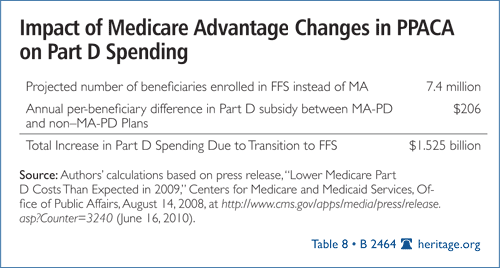
This is not simply a transfer of prescription drug spending from one program to another or from government to patients. It is a net increase in spending for treating the same patients for the same diseases. In other words, it is new, wasteful Medicare spending that will provide no additional benefit.
The PPACA’s Dramatic Negative Effects
The effects of the PPACA on Medicare Advantage enrollees will be dramatic and negative. The most obvious effects will be:
- Reductions in health care services delivered. The PPACA will result in less generous MA benefit packages. The average enrollee will receive $3,714 less per year in the value of his or her coverage by 2017.
- Worse and fewer options for seniors and the disabled. The CMS actuary estimated that there will be 7.4 million fewer MA enrollees (a 50 percent reduction) in 2017 under the PPACA. Some will lose access to the health plans that they would have been able to join under prior law, compelling them to move into the FFS program, which they otherwise would have rejected.
- Fragmentation of care. Mass migration into FFS would exacerbate the well-known problems associated with fragmentation of care and could undermine the viability of integrated health systems that serve both Medicare beneficiaries and other patients.
- Disproportionate harm to low-income and minority beneficiaries. Compared to the average beneficiary, those with incomes in today's dollars between $10,800 and $21,600 are 19 percent more likely to enroll in MA, and those with incomes between $20,000 and $32,400 are 10 percent more likely to enroll in MA. As a result, 70 percent of the cut will be imposed on seniors and disabled with incomes less than $32,400 per year in today’s dollars. Compared to the average Medicare beneficiary, Hispanics are twice as likely and African–Americans are 10 percent more likely to enroll in MA. Thus, the MA cuts represent a regressive tax that disproportionately punishes low-income and minority seniors.
- Higher state and federal Medicaid costs. Many lower-income seniors sign up for MA to obtain comprehensive coverage. Without that option, some would obtain Medicaid support for FFS co-payments and deductibles. For each dual-eligible beneficiary who would have enrolled in MA in 2017 under prior law but is switched to FFS under the PPACA, average annual per-beneficiary Medicaid spending would increase from $54 to $2,012 per beneficiary. The MA cuts on low-income dual-eligibles will cause an estimated 472,000 dual-eligibles to lose their MA plans, increasing costs to Medicaid programs by $924 million annually.
- Higher prescription drug spending. MA plans generally include prescription drug coverage, and their bids for this coverage average less than the premiums of stand-alone Part D prescription drug plans. Beneficiaries who would have been in MA under prior law but will be in FFS will sustain an average loss of $206 per year relative to prior law. The impact on the estimated 7.4 million affected beneficiaries will total more than $1.5 billion annually.
Conclusion
In the final analysis, if the “reforms” in Medicare Advantage made by the Patient Protection and Affordable Care Act go into effect, they will inevitably and unambiguously restrict senior citizens and the disabled to fewer and worse health care choices, reducing their access to quality health care.
—Robert A. Book, Ph.D., is Senior Research Fellow in Health Economics in the Center for Data Analysis at The Heritage Foundation. James C. Capretta is a Fellow at the Ethics and Public Policy Center. The authors gratefully acknowledge the assistance of Joseph R. Antos, Ph.D., in providing valuable feedback and discussions exploring some of the issues discussed in this paper.
Appendix A
Data and Methodology
The estimates are computed on an annual basis for 2017, the first year in which the changes in the MA program will be fully implemented. The basic approach is to compare projected MA benchmarks and enrollment levels for 2017 under prior law with the projected MA benchmarks and enrollment for 2017 under the PPACA. The approach considers the effects of the MA provisions in isolation and then the effects of both the MA provisions and the FFS cuts, which will affect future MA benchmarks according to the formula specified in the new law.
All data used in this analysis were obtained from the CMS, including average FFS spending for each county[26] for 2009; MA benchmarks and enrollment for each county under then-current law for 2009; baseline (that is, prior-law) forecasts for Medicare FFS spending growth;[27] and the CMS Office of the Actuary’s projections of the overall impact of the PPACA.[28] All assumptions used in the calculations are specified in the bill or are the same as those used by the Office of the Actuary to the extent that they have been publicly disclosed.
Benchmark Calculations. The first objective is to calculate MA benchmarks for each county for 2017, when the new formula is fully phased in. They are then compared to what the benchmarks would have been in 2017 under prior law. For consistency, all forecasts of future parameters are taken from the CMS 2010 baseline forecast, constructed in conjunction with the release of the President’s budget and calculated before the PPACA was passed. The same parameters are used for both prior-law and new-law benchmarks.
Prior-law spending figures—both the FFS average spending and the MA benchmarks—were calculated by increasing the 2009 published figures for each county by the growth rate derived from comparing the overall (national baseline) projections for 2017 under prior law to the 2009 figures. The baseline tables show $330.5 billion in total Medicare FFS spending in 2009 for 34.3 million FFS beneficiaries and a projected $552.9 billion in Medicare FFS spending under prior law for 2017 for 42.3 million FFS beneficiaries. This implies an increase of 35.8 percent in per-beneficiary spending in current dollars.
This study follows the Actuary’s assumption that MA bids track the benchmarks on average.[29] The Medicare beneficiary population for each county, as well as the prior-law MA enrollment in each county, was assumed to grow at the same rate as the total population of Medicare beneficiaries.[30]
For spending under the PPACA, average FFS spending for each county was calculated based on the actuary’s forecast of total FFS spending growth under the PPACA in 2017, assuming that each county’s average spending grows at the same rate. The actuary projects total FFS spending of $548.5 billion for 49.7 million FFS beneficiaries in 2017, an increase of 14.6 percent in per-beneficiary spending over 2009.
After making this calculation for each county, the calculations mandated by Section 3201 of the PPACA were made. Counties were sorted by their per-beneficiary FFS averages, and each county was assigned its “applicable percentage” based on its quartile rank.[31] That percentage was used to determine that county’s base benchmark for 2017 under the PPACA.
The PPACA includes provisions for a “quality” bonus of up to 5 percent, which is doubled for certain “qualifying counties.”[32] The Office of the Actuary assumed that the enrollment-weighted bonus would be about 4.5 percent in practice, including the extra amount for qualifying counties. Based on the enrollment projections, this works out to an average bonus of 6.28 percent for qualifying counties and 3.14 percent for other counties. These amounts were added to the base benchmarks to determine the final benchmark for each county.[33]
Dollar Loss. Following the assumptions in the actuary’s report, the dollar loss in benefits was calculated for each beneficiary who would have enrolled in MA under prior law as the difference between the prior-law benchmark and the new benchmark for that county for beneficiaries who remain enrolled in MA. For beneficiaries who would have enrolled in MA under prior law but not under the PPACA, the change in spending is calculated as the difference between the prior-law benchmark and the county FFS average under the PPACA.
Enrollment. The net change in MA enrollment in each county was forecasted by first calculating the overall elasticity of enrollment with respect to benchmarks based on the enrollment projections in the actuary’s report[34] and the change in the overall weighted average benchmark across all counties, assuming constant enrollment. That elasticity was then applied to the change in the benchmark for each county. The actuary forecasts a 50 percent reduction in enrollment and a 25 percent reduction in the weighted average benchmark. This results in an elasticity of 2.0. In other words, for every change of 1 percentage point in the benchmark, MA enrollment will change by 2 percentage points.[35]
This elasticity was then multiplied by the percentage change in the benchmark in each county to calculate the percentage change in MA enrollment in that county. That percentage was applied to the projected enrollment in that county under prior law to obtain the projected enrollment in that county under the PPACA. County-level results were then aggregated by state.
Effects by Race and Ethnicity. Estimates in Table 5 and Table 6 are for the total reduction in Medicare spending for health care for those in each beneficiary group who would have enrolled in MA under prior law. Because of the lack of detailed county-by-county information on the racial and ethnic makeup of Medicare beneficiaries, it was assumed that each group would experience the same average impact per person as the entire beneficiary population. (Simply using county-level population figures for each group would be inappropriate because of differences in the age distributions and, therefore, their shares of the Medicare population in each county.) Ideally, FFS and MA spending patterns for each group would be calculated by county, but this information is not publicly available at this time. Therefore, this should be considered a preliminary estimate.
Limitations of County-Level Data. Some caution is warranted in interpreting the county-level results. The CMS Office of the Actuary used more specific county-level demographic information, specific MA plan bids, and other data to prepare county-level forecasts, but much of this information is not publicly available. Furthermore, CMS suppresses information on plan and county pairs with fewer than 10 enrollees, which affects the calculations, especially for small counties. This will not affect all small counties equally. A small county with only a few MA plans may have accurate data reported, whereas a county with a large number of small plans may have a lower or even zero reported enrollment even if its actual enrollment is higher than enrollment in a county with a smaller number of plans.
Appendix B
Economic Analysis of Cuts in Medicare Advantage Payments
To characterize the effects of the MA payment cuts in the PPACA, we must examine how Medicare beneficiaries and MA plan providers will react to the changes. In other words, the changes will affect both the supply and demand components of the market.
From the MA plan providers’ perspective, the cuts reduce both net revenue and the “rebates” that they can or must offer to beneficiaries in the form of additional benefits or lower premiums. The reduction in revenue makes offering MA plans less attractive as a business proposition, and the reduction in available rebates makes it more difficult for companies offering MA plans to make those plans attractive to Medicare beneficiaries. Both effects lead to a reduction in the number and variety of MA plans and in the generosity of the plans that survive. In other words, the cuts reduce the quality and variety of MA plans.
From the beneficiaries’ perspective, the cuts reduce the level of access to health care services by reducing the generosity of the MA plans that survive the cuts and by eliminating desired MA plans, which forces some patients into the less generous FFS system that they otherwise would have rejected. This demand effect essentially mirrors the supply effect described above. Less generous plans are not only less profitable for the companies offering them, but also less attractive to the consumers who might choose them. The size of these effects can be measured directly as the dollar-value reduction in health care services consumed.
This reduction in consumption can be higher, lower, or equal for those who remain in MA compared to those who switch to FFS, depending on the quartile of the beneficiary’s county. Some patients will choose MA, and some will not. Because different people have different preferences, a beneficiary’s ranking of the plans’ qualitative values may not match their dollar values. Faced with a menu of MA plans and the availability of FFS, some beneficiaries will prefer FFS’s wider choice of providers. Others will prefer the managed-care features (for example, disease management services and integrated care) in some MA plans. In some cases (for example, Kaiser’s integrated health systems), some desired providers might be available only through an MA plan.
The loss in variety of MA plans is an additional negative effect on beneficiaries that is just as real, if not more so, as the dollar value but more difficult to measure directly. MA plans vary substantially in their benefit and co-pay structures, provider networks, and additional benefits. Many MA plans offer disease management services for people with chronic conditions, coordination of care among different physicians, on-call nurses available by phone, and other services that are not available in the Medicare FFS system at any price.
While one of FFS’s most touted benefits is the ability to see “any doctor,” some doctors are available only through MA. For example, a patient who participated in a staff-model HMO program like Kaiser before becoming eligible for Medicare might want to continue to see the same doctors but may be able to do so only if that HMO is available as an MA plan. If the MA plan is withdrawn, the patient might end up in the theoretically “more flexible” FFS system but be forced to change doctors. For someone with multiple chronic conditions who is seeing multiple specialists, the disruption in the continuity of care caused by changing doctors, not to mention the loss of the new specialists’ ability to coordinate with each other, can significantly inconvenience the patient and even adversely affect the patient’s health.
The dollar value of the loss sustained by such a patient would be difficult to measure, and such measurements are impossible using the available data on per-patient spending and current and future MA benchmarks. However, inability to measure something does not mean that its value is zero. Anyone who would have enrolled in an MA plan under prior law and is unable to enroll in the same MA plan under the new law has, by definition, lost their preferred health care option and has therefore sustained a loss. This holds even if the beneficiary finds another MA plan that he or she likes more than FFS (but not as much as the previous plan) or if health care expenses are the same or even higher than they would have been otherwise. (Due to the structure of the changes, the spending level is lower in any case.)
An estimate for changes in federal spending on behalf of Medicare beneficiaries is not the same as the value Medicare beneficiaries place on the services they receive; nor is it the same price they would need to pay to obtain those services outside the Medicare program. In the case of medical services, the value to the patient could be higher or lower than the amount Medicare pays. Because Medicare generally pays less than other payers, the beneficiary would probably need to pay more to replace lost services. In the case of the organizational structure of health care delivery preferred by a patient, a lost MA program might be irreplaceable at any price.
In short, the MA changes are structured in ways that will make almost all beneficiaries who would have chosen MA under prior law worse off. The “lucky” ones will lose only money. The rest will lose both money and their chosen method of obtaining health care, and the changes may also adversely affect the health of some beneficiaries.
